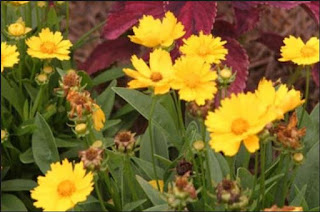Am I showing my age with that title?
I was working in the garden this morning, thinking of Jerry Garcia and the Grateful Dead's lovely loose-strung guitar, while deadheading my Coreopsis. A tedious chore made a little easier with some great memories.
Ah well.
But it made me think about what many new gardeners may be missing - not just some great music, but a second round of flowers later this summer.
Do you deadhead? Do you know what the *!&(#!@*&*^% I'm talking about? Here's what a Coreopsis looks like before deadheading:
See all the spent flower heads? If the deer haven't snipped off the flowers, the stems dry and eventually schrivel up and fall but if I trim them off right away, I've fooled the plant into thinking that it didn't produce enough flowers before winter and it'll make more. Pretty sneaky, right?
Actually, it's manipulating nature to benefit me. The flowers a plant produces are it's heritage - it "knows" that it needs to have progeny and the flowers will develop seeds for next year's plants. If the flowers don't reach that point, the plant will produce more flowers. The second crop may not be as lush as the first one, but it will be quite nice, as the summer winds down, to get just one more bouquet.
There are other reasons for deadheading, too. I like to cut my Catmint (Nepeta mussinii) back after the first flowering so that the bees will get another round of flowers before they hibernate for winter. I don't take the flowers for bouquets so I wouldn't mind if they didn't flower, but it does make the native bees very happy.
And I try very hard to stay ahead of the little red poppies since each seed pod stores thousands of seeds.
Letting this year's plants set those seed pods is just asking for heavy duty work next summer, to say nothing about how the hundreds of poppy plants crowd out all my other herbaceous plants. That was a lesson that took me years to learn since I love self-seeding plants like larkspur, hollyhocks and sunflowers. But deadheading is my way to control the overwhelming amounts of the self-seeders: I remove the spent flowerheads before they form seeds and I'm back in control of what grows in the garden. And it seems kinder to remove the dead flowers than to pull out the young plants next year.
But if you don't get around to deadheading your flowers, reassure yourself that you're not a bad gardener, you're just providing more seeds for the birds to enjoy.
Here's a list of the plants that benefit the most from deadheading: http://extension.psu.edu/plants/master-gardener/counties/chester/how-to-gardening-brochures/deadheading




No comments:
Post a Comment